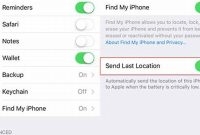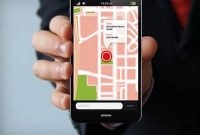Are you worried about the safety of your loved ones or want to keep track of your own phone in case it gets lost or stolen? Luckily, there are some simple steps you can take to track any phone’s location. Whether it’s an iPhone or an Android device, you can easily use built-in features or third-party apps to locate the device in real-time. In this article, we’ll guide you through the process of tracking a phone’s location step-by-step.

How GPS Works
The Global Positioning System (GPS) is a system that uses satellite signals to determine the location of a device on Earth. The system was developed by the United States Department of Defense for military purposes but was later made available for civilian use. Currently, GPS is used by millions of people around the world for different purposes including tracking the location of their mobile phones.
The Physics of GPS
The GPS system works by measuring the time it takes for radio signals to travel from a satellite to the device’s receiver. The device then uses this information to calculate its distance from the satellite. To determine the device’s location, it needs signals from at least three different satellites. The signals contain information about the satellite’s location and the time the signal was transmitted, which is used to calculate the distance between the device and the satellite.
The system is based on the principles of time, speed, and distance. The GPS satellites emit signals at a constant speed, which is the speed of light. The time it takes for the signal to travel from the satellite to the device’s receiver is recorded by the device. Since the speed of the radio signal is a known constant, the device can calculate the distance between itself and the satellite. Once the distances to at least three satellites are known, the device can then triangulate its position on Earth.
Accuracy of GPS
The accuracy of GPS depends on many factors including the number of visible satellites, the location of the user, and the environment. The GPS system is most accurate when the device has a clear view of the sky, so it can receive signals from as many satellites as possible. The accuracy decreases when the device is used in urban canyons, where tall buildings can block some of the signals. The accuracy can also be influenced by space weather, such as solar flares, which can interfere with the signals from the satellites.
How to Turn On Location Services
Enabling location services allows your device to use GPS tracking. Here’s how to turn it on:
For Android Devices:
Open the “Settings” app on your device, then scroll down and select “Location.” From there, you can toggle the “On/Off” switch at the top of the screen to enable location services.
For Apple Devices:
Open the “Settings” app and select “Privacy.” Next, select “Location Services” and toggle the switch to turn on location services for all apps or select specific apps to enable location services for.
What are GPS Tracking Apps?
GPS tracking apps use the GPS receiver in a device to determine its location and transmit it to the app’s servers for tracking purposes. These apps can be used to track a phone’s location in real-time or to view location history. Most GPS tracking apps require access to the device’s GPS, internet, and location services to work properly.
How Do GPS Tracking Apps Work?
When you install a GPS tracking app on your device, it will start collecting data about your location. This data is sent to the app’s servers where it can be stored and accessed by the app’s user. The app will usually display your location on a map interface where you can see your current location, location history, and other useful information such as speed and distance traveled.
To work best, GPS tracking apps need to have access to the device’s GPS. With access to the GPS, the app can calculate the device’s location based on the signals it receives from the GPS satellites orbiting the earth. Most apps also require access to the internet and location services to transmit location information and to display data on the map.
What Are Some Popular GPS Tracking Apps?
- Find My Friends – a location-sharing app that allows you to share your location with family and friends.
- Life360 – a family location tracking app that allows users to view the location of family members on a map.
- Google Maps – a mapping and navigation app that can also be used to track your location history.
How to Use GPS Tracking Apps
GPS tracking apps have become increasingly popular in recent times, especially for parents hoping to keep track of their children or employers keeping their employees in check. These apps make use of the GPS technology already embedded in most smartphones to effectively track the location of the device. Here’s how to use GPS tracking apps:
Step 1: Choose a GPS Tracking App
There are numerous GPS tracking apps available on both the Apple App Store and Google Play Store, including popular options like Find My iPhone, Google Maps, and Life360. Consider what features are most important to you, such as real-time updates or geofencing capabilities, to determine which app is the best fit for your needs.
Step 2: Download and Install the App
Once you’ve chosen an app, download it onto the device you wish to track. Most GPS tracking apps require that you have physical access to the device for the initial installation. After installation, follow the instructions to set up the app and create an account.
Step 3: Log into the App and Adjust Settings
After creating an account, log into the app and modify the settings according to your preferences. Most apps will prompt you to enable location tracking and notifications, allowing you to receive updates on the device’s location. You can also often set up geofences, which send an alert when the device enters or leaves a designated area.
Step 4: Start Tracking!
With the app installed and set up, you can now begin tracking the device. Most apps provide a map view with the device’s location pinpointed. Depending on the app, you may be able to see location history, receive notifications when the device leaves a certain area, or even monitor the device’s screen activity.
Step 5: Educate Yourself on Legal and Ethical Considerations
It’s important to note that GPS tracking can raise legal and ethical concerns, particularly when tracking someone’s location without their knowledge or consent. Make sure you understand the laws in your area and consider ethical implications before using GPS tracking, especially in personal relationships or workplace contexts.
Are There Legal Restrictions on GPS Tracking?
GPS tracking has become a common way to monitor the location of individuals, vehicles, and devices. However, it’s important to note that laws regarding GPS tracking vary by location, so it’s crucial to research and understand the laws in your area before tracking someone’s device. Here are some legal restrictions on GPS tracking that you should be aware of:
1. Consent
In some locations, you may be required to obtain the individual’s consent before tracking their device. It’s important to communicate with the person and inform them about the purpose and scope of the tracking. This will help you avoid any legal consequences that may arise from unauthorized tracking.
2. Warrants
In some cases, law enforcement authorities may need to obtain a warrant before tracking someone’s device. They may also require a warrant before accessing the tracking information from service providers. It’s important to understand the legal procedures surrounding GPS tracking to avoid legal complications.
3. Workplace Privacy
In a workplace setting, employees have a reasonable expectation of privacy. Employers must inform their employees beforehand if they plan to track their company-provided devices or vehicles. This information should be clearly outlined in the employment contracts or policies.
4. Stalking Laws
Some jurisdictions may have stalking laws that make unauthorized tracking illegal. It’s essential to understand the laws in your area to avoid any legal consequences from unauthorized tracking.
5. Domestic Violence Cases
Domestic violence cases may require a different legal approach to GPS tracking. In some locations, tracking may be permitted without consent or a warrant in cases of domestic violence. However, it’s important to consult with a lawyer to understand the specific laws in your area concerning domestic violence cases.
What are the Benefits of GPS Tracking?
GPS tracking is a powerful tool that can provide a wide range of benefits and uses. Here are some of the key benefits of GPS tracking:
1. Keeping Track of Your Own Device
With GPS tracking, you can keep track of your own device, including your smartphone, tablet, or laptop. This can come in handy if you ever misplace your device or it gets stolen. By using GPS tracking, you can locate your device and retrieve it.
2. Monitoring the Safety of Loved Ones
Another use of GPS tracking is monitoring the safety of your loved ones. For example, if you have children, elderly parents, or pets, you can use GPS tracking to keep track of their location and ensure that they are safe. You can even set up geofences, which are virtual boundaries around a specific area, to receive alerts when a loved one leaves or enters a certain area.
3. Tracking the Location of Vehicles or Assets
GPS tracking can also be used to track the location of vehicles or assets, such as construction equipment, boats, or trailers. This can be useful for businesses that need to keep track of their assets or for individuals who want to monitor the location of their vehicles.
4. Improving Fleet Management
For businesses that have fleets of vehicles, GPS tracking can help improve fleet management. By using GPS tracking, businesses can monitor the location of their vehicles, track the routes they take, and monitor driver behavior. This can help businesses optimize routes, reduce fuel costs, and improve overall efficiency.
5. Enhancing Emergency Response
In emergency situations, GPS tracking can be a lifesaver. For example, if someone is lost or injured in a remote area, emergency responders can use GPS tracking to pinpoint their location and provide assistance.
6. Monitoring Employee Productivity
GPS tracking can also be used to monitor employee productivity. By tracking the location of employees, businesses can monitor how much time employees spend at different job sites and ensure that they are using their time effectively.
Frequently Asked Questions
| Questions | Answers |
|---|---|
| Can I track someone else’s phone without them knowing? | No, it is illegal to track someone else’s phone without their knowledge and consent. Always make sure to ask for permission before tracking someone’s phone. |
| What should I do if I lose my phone? | If you lose your phone, immediately try to track it using the steps mentioned in this article. If you are unable to locate it, contact your service provider and report the loss to the authorities. |
| Do I need to install a special app to track my phone? | No, you can simply use the built-in features on your phone to track its location. However, there are also apps available that can offer additional tracking features. |
| Can I track a phone even if it’s turned off? | No, if a phone is turned off, it cannot be tracked. However, you can still see its last known location before it was turned off. |
| Is location tracking always accurate? | No, location tracking can sometimes be inaccurate due to various factors such as poor GPS signal or incorrect settings. However, it can still provide a general idea of the phone’s location. |
Thanks for Reading, and Come Back Soon!
We hope this article has been helpful in enabling you to track your phone’s location. Remember to take the necessary precautions to safeguard your device, such as enabling location services and setting up a passcode. If you have any questions or concerns, leave a comment below. Thanks for reading, and we hope to see you again soon!





